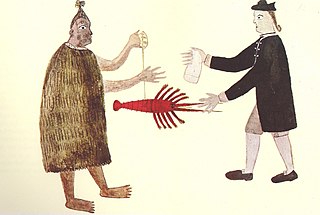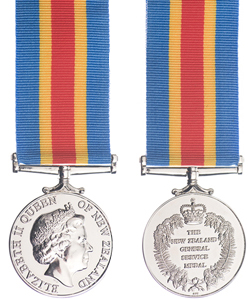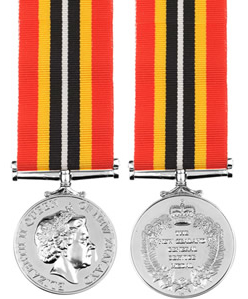The New Zealand Defence Force is the three-branched military of New Zealand. The NZDF is responsible for the protection of the national security of New Zealand and her realm, promoting its interests, safeguarding peace and security, as well as supporting peacekeeping and humanitarian missions. It consists of three services: the Royal New Zealand Navy (RNZN), the New Zealand Army and the Royal New Zealand Air Force (RNZAF), as well as 'tri-service' components. As of June 2023, the NZDF has a strength of 14,996 employees, consisting of 8,669 regular force personnel, 3,260 reserve force personnel and 3,067 civilian members. It is supported by the New Zealand Ministry of Defence (MOD) and is commanded by the Chief of Defence Force (CDF).

The Royal New Zealand Navy is the maritime arm of the New Zealand Defence Force. The fleet currently consists of nine ships. The Navy had its origins in the Naval Defence Act 1913, and the subsequent acquisition of the cruiser HMS Philomel, which by 1921 had been moored in Auckland as a training ship. A slow buildup occurred during the interwar period, and then in December 1939 HMS Achilles fought alongside two other Royal Navy cruisers at the Battle of the River Plate against the German ship, Graf Spee.

The Regional Assistance Mission to Solomon Islands (RAMSI), also known as Operation Helpem Fren, Operation Anode and Operation Rata, began in 2003 in response to a request for international aid by the Governor-General of Solomon Islands. Helpem Fren means "help a friend" in Solomon Islands Pidgin. The mission officially ended on 30 June 2017.

The New Zealand Army is the principal land warfare force of New Zealand, a component of the New Zealand Defence Force alongside the Royal New Zealand Navy and the Royal New Zealand Air Force.

The King's Service Medal is a medal awarded by the government of New Zealand to recognise and reward volunteer service to the community and also public service in elected or appointed public office. It was established in 1975 and is related to the Queen's Service Order. The QSM replaced the Imperial Service Medal as an award of New Zealand.

The military history of New Zealand is an aspect of the history of New Zealand that spans several hundred years. When first settled by Māori almost a millennium ago, there was much land and resources, but war began to break out as the country's carrying capacity was approached. Initially being fought with close-range weapons of wood and stone, this continued on and off until Europeans arrived, bringing with them new weapons such as muskets. Colonisation by Britain led to the New Zealand Wars in the 19th century in which settler and imperial troops and their Māori allies fought against other Māori and a handful of Pākehā. In the first half of the 20th century, New Zealanders of all races fought alongside Britain in the Boer War and both World Wars. In the second half of the century and into this century the New Zealand Defence Force has provided token assistance to the United States in several conflicts. New Zealand has also contributed troops extensively to multilateral peacekeeping operations.

The Cadet Forces Medal is awarded to recognise long and efficient service by Commissioned Officers and non commissioned adult instructors of the UK Cadet Forces: The Army Cadet Force, the Air Training Corps, the Sea Cadet Corps, the Volunteer Cadet Corps and Combined Cadet Force, and Commissioned Officers of the New Zealand Cadet Forces. Authorised by a Royal warrant it is awarded for 12 years service. Additional clasps are issued for every 8 years additional service in New Zealand & for 6 additional years in the UK.

The Royal Solomon Islands Police Force (RSIPF) is the national police force of Solomon Islands and in January 2015 had an establishment of approximately 1,153 officers and 43 police stations across the country.

The New Zealand General Service Medal 2002 (Korea) is a New Zealand campaign medal for service in Korea. The New Zealand General Service Medal 2002 (NZGSM 2002) was established by royal warrant to recognize service since 2000. The NZGSM 2002 (Korea) was authorized by regulation on 5 September 2008. To qualify for this medal personnel must serve thirty days in the Republic of Korea with the United Nations Command Military Armistice Commission (UNCMAC) or the United Nations Command Honour Guard Company. Only service since 1 January 2001 qualifies. This medal replaces the award of the New Zealand General Service Medal 1992 (Non-Warlike) with the Korea 1958-2000 clasp.

The New Zealand General Service Medal 2002 (Timor-Leste) is a New Zealand campaign medal for service in Timor-Leste during and after the 2006 East Timorese crisis between 28 April 2006 and 31 December 2012.

The New Zealand Special Service Medal (NZSSM) was established by royal warrant by Elizabeth II, Queen of New Zealand on 23 July 2002. The medal serves to recognize military service that would not otherwise be recognized by a Campaign medal.

The New Zealand Defence Service Medal (NZDSM) is a military service medal awarded to former and current members of the New Zealand Defence Force, for qualifying service since 3 September 1945. It is expected that at least 160,000 former service personnel and more than 7,000 currently serving NZDF personnel are eligible to receive the medal.

The New Zealand General Service Medal 2002 (Afghanistan) (NZGSM 2002 (Afghanistan)) is a campaign medal of New Zealand that recognizes service in the War in Afghanistan. The Queen of New Zealand authorized the creation of a new General Service Medal for the recognition of service taking place after December 2001 with a royal warrant on 23 July 2002. Regulations to establish the NZGSM 2002 (Afghanistan) were published 16 January 2003.

The New Zealand Suffrage Centennial Medal 1993 was established by Royal Warrant on 1 July 1993. It was created to commemorate Women's suffrage in New Zealand and to recognize those New Zealand and Commonwealth citizens who had made a significant contribution to women's rights or women's issues in New Zealand. The medal was only awarded in 1993.

The New Zealand Meritorious Service Medal is a meritorious and long service award for members of the New Zealand Defence Force. Initially established on 28 April 1898 as the Meritorious Service Medal, only members of the New Zealand Army were eligible for award. In 1985, a Royal Warrant established the current criteria for the medal making all members of the Army, Navy, and Air Force eligible for the award. Members of the defence forces above the rank of sergeant, who have at least 21 years of service, and hold their service's Long Service and Good Conduct Medal are eligible for the medal. The New Zealand Meritorious Service Medal is to be replaced by the New Zealand Defence Meritorious Service Medal, though holders of the superseded medal are still entitled to continue wearing it.
The Long Service and Good Conduct Medal is a military award recognizing 14 years of exemplary and unblemished service by non-commissioned and other ranks members of the New Zealand Defence Force. Established in 1985, these medals replaced the British Long Service and Good Conduct Medals with specific versions for New Zealand. There are three version of the Long Service and Good Conduct Medal, one each for the New Zealand Army, Royal New Zealand Navy, and the Royal New Zealand Air Force.
The New Zealand Defence Meritorious Service Medal is a military award of the New Zealand Defence Force (NZDF). Established by Royal Warrant 15 October 2013, the medal may be awarded to recognize meritorious exceptional performance, commitment, or innovation. Military and civilian personnel of the NZDF are eligible for this award regardless of rank or time in service. It will supersede the New Zealand Meritorious Service Medal.
The New Zealand Police Meritorious Service Medal is a police award of the New Zealand Police. Established by Royal Warrant 15 October 2013, the medal may be awarded to recognize meritorious exceptional performance, commitment, or innovation.
















